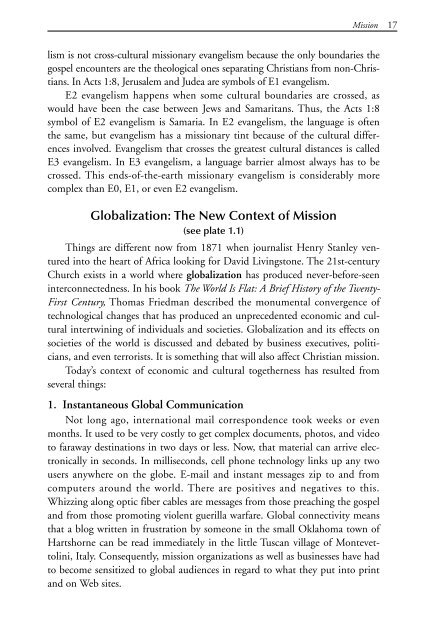discovering missions - Southern Nazarene University
discovering missions - Southern Nazarene University
discovering missions - Southern Nazarene University
Create successful ePaper yourself
Turn your PDF publications into a flip-book with our unique Google optimized e-Paper software.
245187 Disc Missions ins 9/6/07 1:04 PM Page 17<br />
lism is not cross-cultural missionary evangelism because the only boundaries the<br />
gospel encounters are the theological ones separating Christians from non-Christians.<br />
In Acts 1:8, Jerusalem and Judea are symbols of E1 evangelism.<br />
E2 evangelism happens when some cultural boundaries are crossed, as<br />
would have been the case between Jews and Samaritans. Thus, the Acts 1:8<br />
symbol of E2 evangelism is Samaria. In E2 evangelism, the language is often<br />
the same, but evangelism has a missionary tint because of the cultural differences<br />
involved. Evangelism that crosses the greatest cultural distances is called<br />
E3 evangelism. In E3 evangelism, a language barrier almost always has to be<br />
crossed. This ends-of-the-earth missionary evangelism is considerably more<br />
complex than E0, E1, or even E2 evangelism.<br />
Globalization: The New Context of Mission<br />
(see plate 1.1)<br />
Mission 17<br />
Things are different now from 1871 when journalist Henry Stanley ventured<br />
into the heart of Africa looking for David Livingstone. The 21st-century<br />
Church exists in a world where globalization has produced never-before-seen<br />
interconnectedness. In his book The World Is Flat: A Brief History of the Twenty-<br />
First Century, Thomas Friedman described the monumental convergence of<br />
technological changes that has produced an unprecedented economic and cultural<br />
intertwining of individuals and societies. Globalization and its effects on<br />
societies of the world is discussed and debated by business executives, politicians,<br />
and even terrorists. It is something that will also affect Christian mission.<br />
Today’s context of economic and cultural togetherness has resulted from<br />
several things:<br />
1. Instantaneous Global Communication<br />
Not long ago, international mail correspondence took weeks or even<br />
months. It used to be very costly to get complex documents, photos, and video<br />
to faraway destinations in two days or less. Now, that material can arrive electronically<br />
in seconds. In milliseconds, cell phone technology links up any two<br />
users anywhere on the globe. E-mail and instant messages zip to and from<br />
computers around the world. There are positives and negatives to this.<br />
Whizzing along optic fiber cables are messages from those preaching the gospel<br />
and from those promoting violent guerilla warfare. Global connectivity means<br />
that a blog written in frustration by someone in the small Oklahoma town of<br />
Hartshorne can be read immediately in the little Tuscan village of Montevettolini,<br />
Italy. Consequently, mission organizations as well as businesses have had<br />
to become sensitized to global audiences in regard to what they put into print<br />
and on Web sites.

















